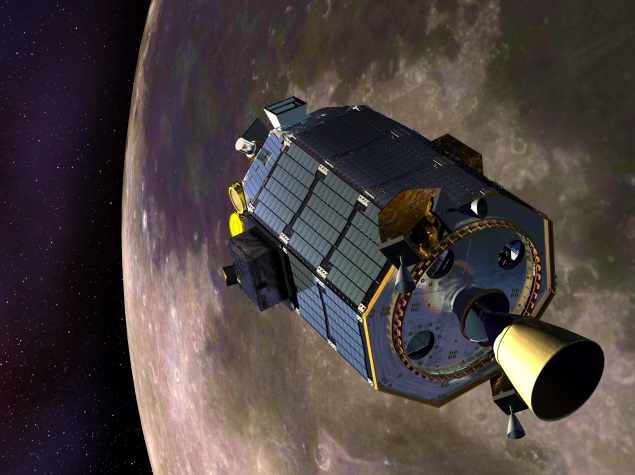- Home
- Science
- Science News
- NASA's moon orbiting robot crashes down
NASA's moon-orbiting robot crashes down

Researchers believe LADEE likely vaporized upon contact because of its extreme orbiting speed of 3,600 mph (5,800 kph), possibly smacking into a mountain or side of a crater. No debris would have been left behind.
"It's bound to make a dent," project scientist Rick Elphic predicted Thursday.
By Thursday evening, the spacecraft had been skimming the lunar surface at an incredibly low altitude of 300 feet (100 meters). Its orbit had been lowered on purpose last week to ensure a crash by Monday following an extraordinarily successful science mission.
LADEE - short for Lunar Atmosphere and Dust Environment Explorer - was launched in September from Virginia. It completed its primary 100-day science mission last month and was on overtime.
The extension had LADEE flying during this week's lunar eclipse; its instruments were not designed to endure such prolonged darkness and cold. But the small spacecraft survived - it's about the size of a vending machine - with just a couple pressure sensors acting up.
The mood in the control center at Nasa's Ames Research Center in Mountain View, California, was upbeat late Thursday afternoon, according to project manager Butler Hine.
"Having flown through the eclipse and survived, the team is actually feeling very good," Hine told The Associated Press in a phone interview.
The uncertainty of the timing of LADEE's demise had the flight controllers "on edge," however, he said.
"Each orbit could be the last one and you don't know. It's kind of a crapshoot," Hine said. "So I'd day everybody's in good spirits, but there's that uncertainty. Is it going to happen next hour or three hours from now or are we going to make it all the way through Sunday?"
As it turns out, LADEE succumbed within several hours of Hine's comments. It will be at least a day or two before Nasa knows precisely where the spacecraft ended up; the data cutoff indicates it smashed into the far side of the moon, although just barely.
LADEE did not have enough fuel to remain in lunar orbit beyond mission's end and keep collecting science. So from the outset, Nasa planned to crash the spacecraft into the back side of the moon, far from the Apollo artifacts left behind during the moonwalking days of 1969 to 1972.
During its mission, LADEE identified various components of the thin lunar atmosphere - neon, magnesium and titanium, among others - and studied the dusty veil surrounding the moon, created by all the surface particles kicked up by impacting micrometeorites.
"LADEE's science cup really overfloweth," Elphic said earlier this month. "LADEE, by going to the moon, has actually allowed us to visit other worlds with similar tenuous atmospheres and dusty environments."
For the latest tech news and reviews, follow Gadgets 360 on X, Facebook, WhatsApp, Threads and Google News. For the latest videos on gadgets and tech, subscribe to our YouTube channel. If you want to know everything about top influencers, follow our in-house Who'sThat360 on Instagram and YouTube.
Related Stories
- Samsung Galaxy Unpacked 2025
- ChatGPT
- Redmi Note 14 Pro+
- iPhone 16
- Apple Vision Pro
- Oneplus 12
- OnePlus Nord CE 3 Lite 5G
- iPhone 13
- Xiaomi 14 Pro
- Oppo Find N3
- Tecno Spark Go (2023)
- Realme V30
- Best Phones Under 25000
- Samsung Galaxy S24 Series
- Cryptocurrency
- iQoo 12
- Samsung Galaxy S24 Ultra
- Giottus
- Samsung Galaxy Z Flip 5
- Apple 'Scary Fast'
- Housefull 5
- GoPro Hero 12 Black Review
- Invincible Season 2
- JioGlass
- HD Ready TV
- Laptop Under 50000
- Smartwatch Under 10000
- Latest Mobile Phones
- Compare Phones
- Moto G15 Power
- Moto G15
- Realme 14x 5G
- Poco M7 Pro 5G
- Poco C75 5G
- Vivo Y300 (China)
- HMD Arc
- Lava Blaze Duo 5G
- Asus Zenbook S 14
- MacBook Pro 16-inch (M4 Max, 2024)
- Honor Pad V9
- Tecno Megapad 11
- Redmi Watch 5
- Huawei Watch Ultimate Design
- Sony 65 Inches Ultra HD (4K) LED Smart TV (KD-65X74L)
- TCL 55 Inches Ultra HD (4K) LED Smart TV (55C61B)
- Sony PlayStation 5 Pro
- Sony PlayStation 5 Slim Digital Edition
- Blue Star 1.5 Ton 3 Star Inverter Split AC (IC318DNUHC)
- Blue Star 1.5 Ton 3 Star Inverter Split AC (IA318VKU)
-
 iPhone 14, iPhone SE Sales in EU to Be Discontinued Due to Upcoming Regulation: Report
iPhone 14, iPhone SE Sales in EU to Be Discontinued Due to Upcoming Regulation: Report
-
 OnePlus Open 2 Launch Timeline Leaked; Might Debut Later Than Expected
OnePlus Open 2 Launch Timeline Leaked; Might Debut Later Than Expected
-
 Google Blasts Chrome Sale as ‘Extreme’ Remedy at Odds With Law
Google Blasts Chrome Sale as ‘Extreme’ Remedy at Odds With Law
-
 Samsung Galaxy S25 Slim Specifications Leaked; Might Be Thicker Than iPhone 17 Air
Samsung Galaxy S25 Slim Specifications Leaked; Might Be Thicker Than iPhone 17 Air












